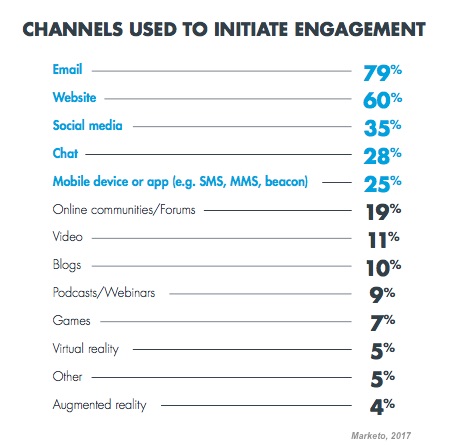
With some degree of regularity, I talk with programmers, marketers, and digital staffers who tell me, “We’re killing it on social media.”
Of course, they’re often referring to the metrics, the accumulation of “likes” and “followers,” and other statistical measures of successful interaction that are – at their core – just numbers. They omit the emotional connection that truly drives engagement and loyalty.
And to that point, a new study from Marketo, conducted among marketers and consumers in France, Germany, the UK, and the US suggests that many companies and brands may be missing the mark = and not even realize it.
Marketing Profs’ Ayaz Nanji writes that B2C (business to consumer) brands – like radio stations – may be inflating their ability to genuinely connect with their audiences socially. In fact, nearly half (47%) of these consumers say brands could improve their game.
The gap between what companies say and what their audiences think is a wide one. In the study, more than 8 in 10 marketers (83%) are more positive about their engagement than the one-third of consumers (33%) who agree they’re doing a good job.
Where’s the friction? The biggest complaints from people revolve around brands that send too much irrelevant content or don’t have anything to offer or say outside of their core products and services.
And the stats that caught my attention were on this chart, showing the most frequent channels of engagement, according to how consumers say they interact with brands:
 It’s interesting how the two “oldest” digital channels – email and websites – outflank social media, chat, apps, forums, and videos. And yet, I’d bet that if you inventoried resources that radio deploys in its pursuit of engagement, the pecking order might look a lot different.
It’s interesting how the two “oldest” digital channels – email and websites – outflank social media, chat, apps, forums, and videos. And yet, I’d bet that if you inventoried resources that radio deploys in its pursuit of engagement, the pecking order might look a lot different.
And that begs the question of whether radio brands are truly involved with outreach activities congruent with how they’re valued by the audience. Are there too many messages, posts, and emails? And is the messaging on target? Of course, a simple database survey could take the mystery out of several of these questions?
And engagement might get a whole lot better.
So, are you “killing it in the social space?”
And is that the optimal way your audience wants to engage with your station?
- What To Do If Your Radio Station Goes Through A Midlife Crisis - April 25, 2025
- A 2020 Lesson?It Could All Be Gone In A Flash - April 24, 2025
- How AI Can Give Radio Personalities More…PERSONALITY - April 23, 2025




Fred,
Like you, I find that list of engagement channels very interesting. My sense is that many radio stations place too much emphasis on social media and not enough on websites and email marketing.
One thing that’s missing from the list: search engines. I’m not sure if that’s because it wasn’t included in the question, or it just didn’t occur to respondents. But I suspect a lot of brand engagements start with a Google search before continuing on to one of these other channels.
Seth, thanks. I’m betting that it was a close-ended question with fixed choices. And you’re probably correct about search starting the process.
Engagement is a circle. Not a one way street. Too many brands think that a post or an email, even if personalized or targeted is the top of the pyramid.
I’m a big believer in, and had great success with, marketing oriented long form surveys that give the listener an opportunity to comment on just about every aspect of the station. It’s not necessarily actionable information, but it can inform your judgement.
For public radio, this gives you a HUGE mound of listener specific information that can be tagged in your CRM and used to walk a listener down the membership path and a member up the contribution ladder.
The surveys I’ve created were 30-40 questions long and took about 20 minutes to complete, even more if the respondent really got into it. With the proper incentive (a drawing for the hottest tech product or front row tickets) you can get enough completed surveys to feel you’ve deepened your station’s relationship with the audience.
I love your opening line, Stephen. There are no shortcuts. And like you, I’m believe that if you ask the right questions and take the time to listen to the answers, the audience can guide your strategy. Thanks for the insightful comment.
Killing it on social media typically involves Vanity Metrics. Numbers that make you feel great, such as page views, downloads and likes, but do not measure the numbers that really matter such as active users, engagement, and ultimately revenue and profits. There’s a great blog post by Eric Ries in HBR a few years back. https://hbr.org/2010/02/entrepreneurs-beware-of-vanity-metrics
Precisely, Andrew. And thanks for providing a link to Eric Ries’ post.